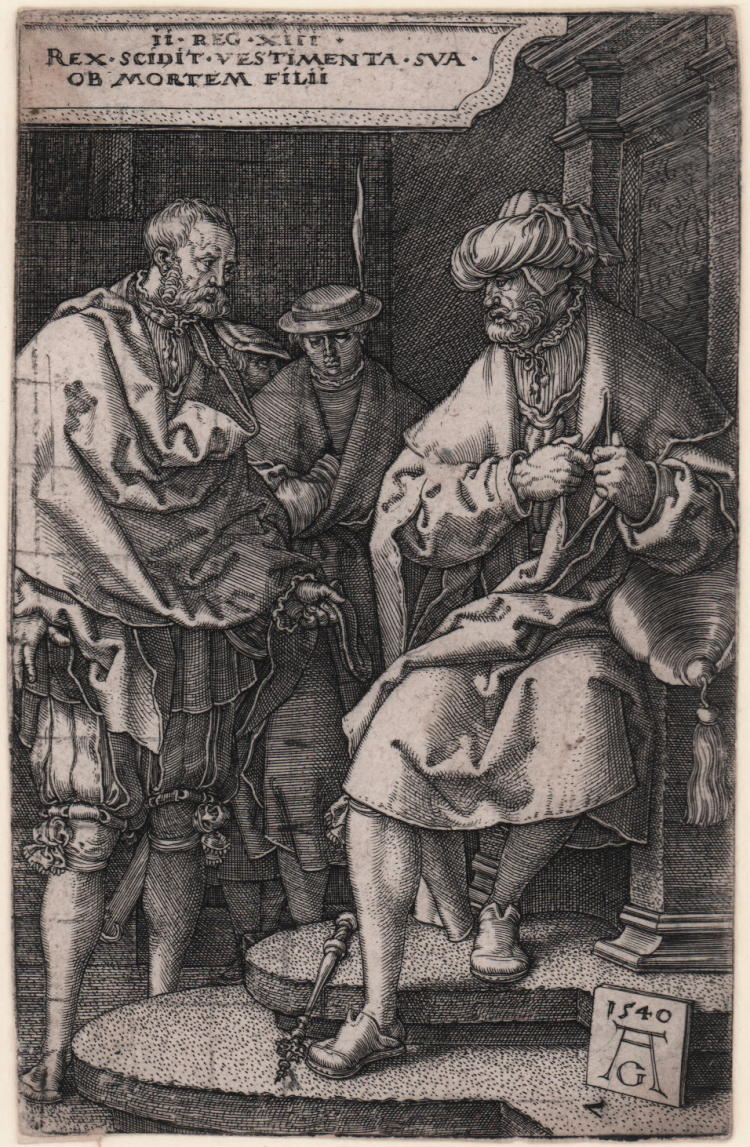




| Reference: | S28344 |
| Author | Heinrich ALDEGREVER |
| Year: | 1540 |
| Measures: | 79 x 119 mm |



| Reference: | S28344 |
| Author | Heinrich ALDEGREVER |
| Year: | 1540 |
| Measures: | 79 x 119 mm |
King David tearing his clothes in grief; enthroned at right; standing at left Jonadab and a servant.
Engraving, 1540, signed with monogram and dated on a tablet at lower right. Lettered on a tablet at upper left: 'II REG XIII/ REX SCIDIT VESTIMENTA SUA/ OB MORTEM FILII'.
Plate 7 of the The Story of Amnon and Tamar, a series of seven engravings. Example of the first state of two.
The story is told in the Bible, in the Second Book of Samuel. Tamar was so beautiful that her half-brother Amnon, King David's firstborn son, fell in love with her. Amnon, advised by a friend who was worried about him, pretended to be ill and asked his father to have her call him so that he could bring him pancakes made with his own hands. The father agreed but Amnon arranged to be alone with Tamar and proposed that she lie with him. At her sister's refusal Amnon raped her. After raping her, Amnon began to feel deep hatred for her and had her thrown out. Tamar fled by tearing her clothes and sprinkling dust on her head (a typical sign of mourning and despair in Jewish culture). As she fled, she met another brother, Absalom, who, understanding what had happened, advised her not to say anything to anyone because he would take care of it. Tamar stayed in Absalom's house for two years, after which Absalom, on the occasion of sheep shearing, invited King David and all his sons to celebrate. Seeing the king's refusal, Absalon asked that at least his brother Amnon come. When Amnon was drunk, he had his servants kill him to avenge the dishonor done to Tamar.
Shortly before 1520, some young artists in Albercht Dürer's circle took to making very small engravings that challenged the viewer with a miniature world of new secular subject matter and unconventional interpretations of traditional themes. Because of the small size of their engravings, these artists have long been affixed with the collective, and unflattering, name of Small Nuremberg Masters. The core of the group consists of three artists from Nuremberg, Hans Sebald & Bartel Beham and Georg Pencz, and in addition Jacob Bink from Cologne and Heinrich Aldegrever from Soest.
Beautiful proof, printed on contemporary laid paper without watermark, trimmed to the copperplate, traces of "squaring up" in pencil, otherwise in very good condition.
Bibliografia
New Hollstein (German), The New Hollstein: German engravings, etchings and woodcuts 1400-1700 (28.I); Bartsch; Le Peintre graveur (VIII.369.28).
Heinrich ALDEGREVER (Paderborn, 1502; Soest, Westfalia, 1555–61)
|
German engraver, painter and designer. He was the most important graphic artist in Westphalia in the 16th century. His reputation rests largely on his ornamental designs, which make up about one third of his c. 300 engravings. They were principally intended as models for metalworkers but were also adapted by other craftsmen for such decorative arts as enamel, intarsia and book illustration. Aldegrever followed Dürer and the Nuremberg LITTLE MASTERS, deriving models for his paintings and subject prints as well as a full repertory of Renaissance ornamental motifs: fig and acanthus foliage, vases and cornucopia, combined with putti and satyrs, tritons, mermaids and dolphins, sphinxes, masks and medallions. From the beginning of his career Aldegrever was aware of the artistic trends of the time: the Dürer influence was strongest at its outset yielding somewhat in work of the 1530s to Mannerist tendencies under Netherlandish influence, though never waning entirely.
|
Heinrich ALDEGREVER (Paderborn, 1502; Soest, Westfalia, 1555–61)
|
German engraver, painter and designer. He was the most important graphic artist in Westphalia in the 16th century. His reputation rests largely on his ornamental designs, which make up about one third of his c. 300 engravings. They were principally intended as models for metalworkers but were also adapted by other craftsmen for such decorative arts as enamel, intarsia and book illustration. Aldegrever followed Dürer and the Nuremberg LITTLE MASTERS, deriving models for his paintings and subject prints as well as a full repertory of Renaissance ornamental motifs: fig and acanthus foliage, vases and cornucopia, combined with putti and satyrs, tritons, mermaids and dolphins, sphinxes, masks and medallions. From the beginning of his career Aldegrever was aware of the artistic trends of the time: the Dürer influence was strongest at its outset yielding somewhat in work of the 1530s to Mannerist tendencies under Netherlandish influence, though never waning entirely.
|